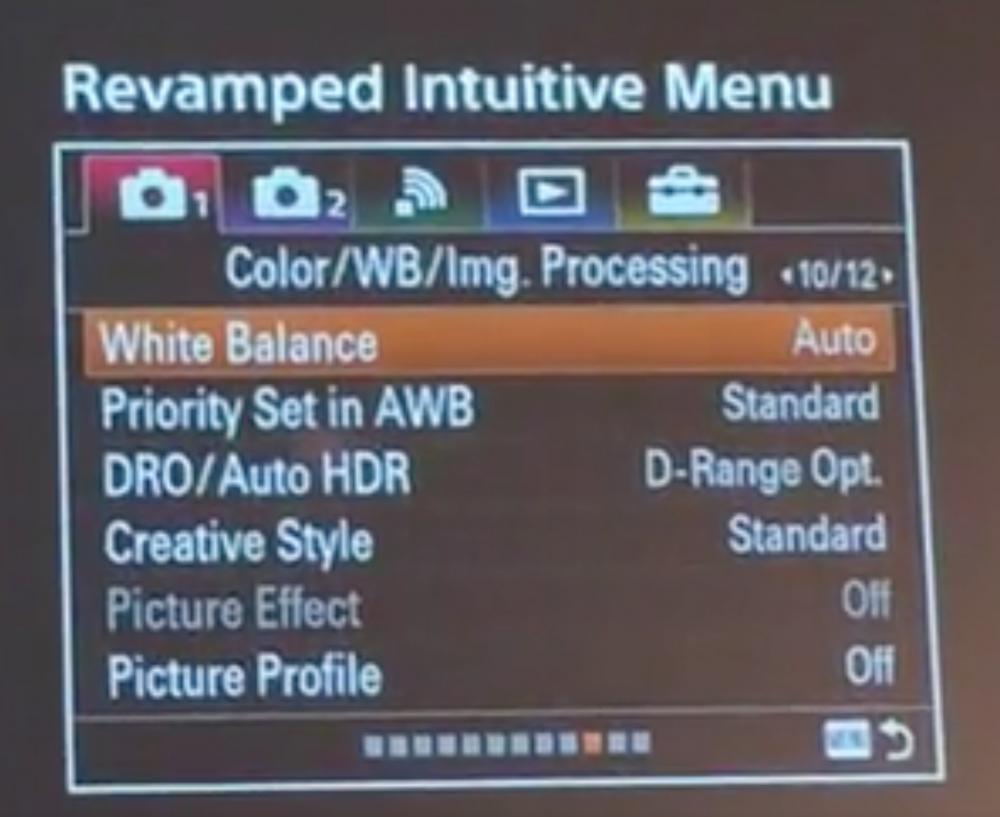-
Posts
15,506 -
Joined
-
Last visited
Content Type
Profiles
Forums
Articles
Everything posted by Andrew Reid
-
You need to be in stills mode. Use the Stills/Movie switch to put it into stills mode and then try again.
-
I did get an invite to the FS7 II event but couldn't go to Barcelona in the end due to getting ill. This is not about disliking one company or liking another. It is about liking one camera over another. You are free to have a different opinion about your cameras but it's a bit questionable attacking someone for being against your favourite brand. Is this the kind of hyper consumerist world we're living in now? Post-fact?
-
Not necessarily. It may be a Nikon design and Sony's factory just built it. The one in the X-T2 might be a Sony design, Sony built. Sensor looks very similar to the one in the A6300 to me. Who knows... All I can say is that the X-T2's colour isn't as nice as I expected it to be, with rather waxy skintones compared to Canon and Panasonic. It seems the few people who are getting crazy high saturation and crushed blacks on the comparison shot really need to dial down their displays, calibrate them to S-RGB or just plain upgrade.
-
Canon have made the biggest step forwards with their DSLR technology this year that we've seen since 2008 and the 5D Mark II. However it isn't the 5D Mark IV that has me excited so much the 1D X Mark II. This is a camera that will see out the next 6 years as the benchmark for others to follow. Read the full article
-
Metabones EF XL working fine on my Panasonic G80.
-
Hacked Samsung NX500 is shooting some very nice 2.5K. I wish Blackmagic would concentrate more on the consumer priced stuff again and give us a BMCC 2.0
-
This is really exciting stuff. 10bit will be great for the SD card Canon bodies in upping resolution while keeping the date rate under the max of the SD card slot. 60D now 1080p for 12 seconds! Will be interesting to see if it works in crop mode on the 5D Mark III for longer record times in 3K
-
It's a "big problem" for Nikon only if they are designing a camera by committee, with one half of the table saying one thing and the other half saying another, which I'm afraid it looks like they are doing, at least in terms of the product feedback from pros.
-
NX1 the best choice by far, you need to spend over $6000 to beat it for 120fps However if you don't mind the small sensor and fixed lens - RX100 IV has the best resolution and even 240fps, with less moire.
-
It won't be more profitable in the long run when people are too afraid to buy a Sony camera for fear that in 2 months they will make it obsolete.
-
It wouldn't be quite the rip off it is if Sony had done what they should have done. Announce the A6300 and A6500 TOGETHER at the same time and likewise back when the A7R II was announced, release it with the A7S II at the same time, allow us to make a choice and to buy just one, not stumble into the A7R II or A6300 then end up buying the A6500 or A7S II as well because they're better specced for video... I actually think as a sales tactic this is disastrous and we will tire of it very quickly. They have maintained this illusion of constant technological progress... if you think however that in the 6 months between the A6300 and A6500 suddenly Sony invented 5 axis image stabilisation and a touch screen you are mistaken.
-
Not with any real reliability or precision to be honest. The 1D X Mark II walks all over it. Ok... it is $6k but with something this important it is the difference between a wreaked shot or a great one.
-
Plus 20% VAT = 1507 euros, plus import duties = something higher + hell knows what else = 1700 Personally I miss the days of bargain GH2s and NEX cameras... the whole thing seems to be shifting higher and higher with every passing month as the consumer market dies and smartphones take over. At this rate there won't be an interesting camera under $3k. And also, the A6300 should never have existed. Majorly flawed, with a shelf life of approximately 30 seconds. There was absolutely nothing to stop Sony putting a touch screen in that and 5 axis stabilisation. The A6500 is a very interesting update but their game is clear, and I am angry at them, as I feel we have wasted our money...not once, not twice, but many times now with these quickly obsolete cameras.
-

Canon 6D vs 5D MkIII vs 7D MkII for filming with EOSHD C-Log
Andrew Reid replied to JazzBox's topic in Cameras
Out of those the 5D Mark III is of course the best but it is not exactly the cheapest. Oddly I find the 50MP 5DS shoots the best quality 1080p of all the Canon DSLRs right now. It's very detailed. -
29ms, I don't believe that. Looks more like 15-20ms as it is noticeably better than the NX1 skew in my tests.
-
it really depends on the creative work you're doing, if you're doing hour long takes, live events, continuous recording and interviews, news, that kind of thing then of course a shoulder mount would help and there are plenty of rigs, have been for 6 years, that can easily convert a DSLR form factor for that purpose... For music videos, short films, mood pieces, you are doing short takes, usually no longer than 1 minute each before you stop and re-take, direct, talk to actors, etc. and many times there's a tripod involved, so ENG is not the only design in town!
-
I'm going to have to defend the DSLR and mirrorless cameras big time... ENG shoulder shooting is overrated. I personally don't want to lug around a big heavy camera with rails and a shoulder mount that can only be shot with in one position at one height. At least with a DSLR you have a choice whether you rig it up for ENG style shooting or something more minimal. When you have 5 axis stabilisation and a body that weighs less than 1kg, it really isn't that hard Indeed when you have an EVF (either built in or via loupe) you basically have the same shooting style as a Super 16mm camera and nobody is suggesting those aren't suitable for film work. Times change. The 18MP refers to 6000 x 3000 in 6K Photo Mode (the maths is 6000 * 3000 = 18 million pixels) If the final sensor is in that aspect ratio I will eat my hat There's no way it is going to be 18MP. It will be in region of 24-28MP if it supports 6K res
-
Am I the only one who preferred the GH1 and GH2 to when the GH3 gave us that 'serious' body? Slimmer, smaller, more fun, more nimble controls, no daft rear wheel that you can't do full turns off because the rubber of the rear grip doesn't drop away next to it I also prefer the original A7S to the A7R II / A7S II. Again, slimmer, more nimble controls, less complexity, less soulless and more shiny!
-

Sony seem to have botched their menu re-design
Andrew Reid replied to Andrew Reid's topic in Cameras
The Samsung NX1's menus are superb. Very feature packed camera yet I'm never lost on page 9 of 12 So underrated how ergonomic that camera turned out to be.... Canon and Fuji also understand menu design. Panasonic good logically, but a little too much scrolling, button pressing. -
The ergonomics for stills stand out vs the A7S II, much nicer. For video the live-view experience is a big improvement with much higher frame rate screen, very quick to switch between video and stills mode on a lever, very quick to pause the AF by pressing a function button (either toggle or hold) or lock onto a subject simply by pressing the touch screen. The AF system on this camera is the best I've ever used be it video or stills, it rocks in both. Dual Pixel AF is an absolute bomb. It recognises faces in near darkness even when you can't see them yourself on the screen. It never seems to slow down much even in low light. Even at F1.2 on my beloved EF 50mm F1.2L it does a very good job so you barely have to think about focus. Not used manual focus on it yet ONCE. The automatic white balance maintains a warm naturalness to scenes with mixed indoor / outdoor lights, very nice indeed and never seems too cold or clinical. Colour is astounding on this camera. The 120fps quality is good for that kind of frame rate, and it is full frame. Better than the A7S II 120fps. It is almost the same quality as the 1080/24p. The 1080/24p is as detailed as the 1D C's full frame 1080/24p but without the moire correction. Not tried the HDMI output yet but has option for 1080/60/50p in the menu, so should do nice 1080/60p 1.3x crop when set to 4K 60p mode in-cam. 4K image quality is as you'd expect Fucking good. The file sizes are a downside as is the moire in full frame video mode 1080p. I used to shoot a lot of 1080p on the 1D C to get around the massive MJPEG codec. Rolling shutter MUCH less than A7S II and 1D C in 4K! Will say a lot more in the review, as only had the camera for 2 days! Bought it in Berlin at a store brand new.
-
I ended up getting a 1D X Mark II as well. It's astoundingly good but it has ONE really surprisingly disappointing aspect - they removed the digital moire filter in 1080p mode - it has more moire than the 5D Mark III and 1D X 1080p. A backward step for 1080/24p full frame. Good job there are plenty of other cameras much cheaper than shoot good full frame 1080p like the A7S!
-
Wow that is small. No word on video though?
-
Very nice. Fingers crossed for some kind of decent video mode. X-T2 shows a lot of improvement for Fuji.
-
A-mount? 2x crop sensor? Both the Sony A99 II and Panasonic GH5 have a few aspects which look out of place in the high end market of 2016. However sometimes the most simple things are the problem. Read the full article




